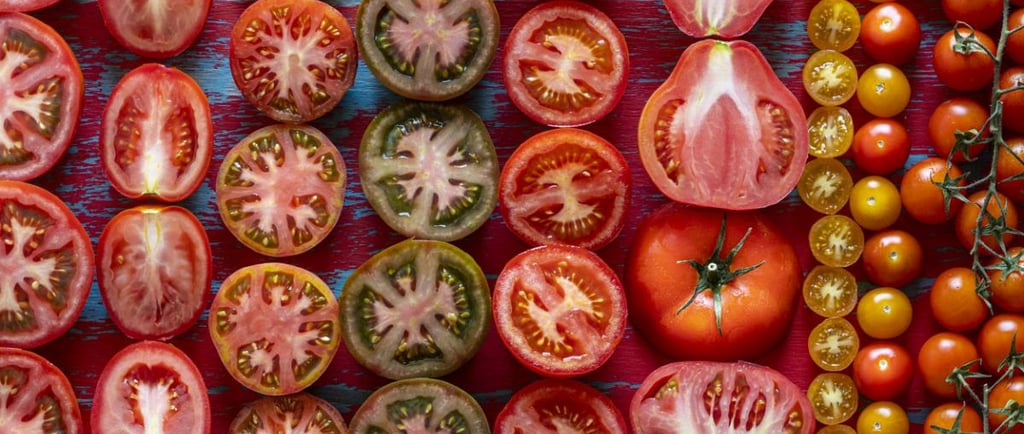The Spanish Tomato:
sebastián Bish Adell


The Spanish Tomato: A Journey Through Its Varieties and Growing Regions
Hey there, flavor chasers and lovers of fresh produce! Today, we're diving into the fascinating world of the Spanish tomato. It's way more than just a vegetable in our diet; it's the very heart of our cuisine, from the most refreshing gazpacho to the richest sauce. Spain isn't just a big consumer of tomatoes; we're also a leading producer globally, famous for the quality and sheer diversity of our varieties.
If you've ever wondered why Spanish tomatoes have such a special taste or what hidden gems our farmlands hold, you're in the right place. Get ready to discover the main growing regions, the most iconic varieties, and the philosophy behind their success.
The Spanish Tomato: A Link to the Land and Tradition
The story of the tomato in Spain goes all the way back to the 16th century when it arrived from the Americas with the conquistadors. While it was initially grown as an ornamental plant, its adaptability to the Mediterranean climate and its eventual acceptance in cooking turned it into a fundamental pillar. Today, 70% of the magic of our tomatoes lies in the unique combination of terroir, traditional varieties, and cultivation techniques that have been perfected over centuries.
Iconic Growing Regions: Spain is a mosaic of climates, and several regions stand out for their tomato production, each bringing unique characteristics:
Andalusia (especially Almería): This is the main producing region. Its warm, sunny climate, with extensive high-tech greenhouses, allows for production for much of the year. Almería tomatoes are known for their consistency and form the basis of much of our exports and fresh consumption.
Murcia: Another key region with a large area of greenhouses. It shares many characteristics with Almería in terms of production and varieties.
Extremadura and the Ebro Valley (Navarra, La Rioja, Aragón): These areas are pillars in the production of tomatoes for industry (sauces, preserves, juices), although they also grow for fresh consumption. The continental climate favors varieties with a higher concentration of solids.
Valencian Community (El Perelló, Muchamiel): Famous for its seasonal tomatoes, grown outdoors. The influence of the sea breeze and salty soils, as in El Perelló, gives them exceptional flavor and freshness.
Canary Islands: Their subtropical climate allows for almost uninterrupted tomato production throughout the year, with varieties known for their sweetness.
Tomato Varieties: A Universe of Flavors and Textures: In Spain, we cultivate an impressive diversity of tomatoes, each with its own special qualities:
"Pera" Tomato (Roma): Elongated and meaty, it's the undisputed king for gazpachos, salmorejos, and sauces due to its low water content and dense pulp.
"Redondo" or "Salad" Tomato (Valencian type, Moneymaker): Round and large, juicy and aromatic, this is the classic for fresh salads. The El Perelló Tomato is a highly prized Valencian variant.
"Rosa" Tomato (like Rosa de Barbastro): Large, with thin skin and a pink color. Its flesh is very juicy, sweet, and with low acidity, ideal for eating simply with good olive oil and salt.
"Raf" Tomato: Famous for its irregular, ribbed shape, dark green color, and unique, sweet yet slightly acidic, very meaty flavor. Originally grown in Almería, it's highly valued for fresh consumption.
"Muchamiel" Tomato: Originating from Alicante, medium-sized, thin-skinned, and with a mild, sweet flavor.
Cherry Tomato: Small and very sweet, perfect for salads, appetizers, or as a snack. They are grown in greenhouses and are available year-round.
"Corazón de Buey" Tomato (Oxheart): Large, heart-shaped, very meaty, and with few seeds. Ideal for salads and stuffing.
Kumato® Tomato: A dark-colored (brownish-red) hybrid variety, sweet, with firm, crunchy flesh even when ripe. Popular in salads.
Enjoying the Tomato: Uses, Tips, and Your Experience
The tomato is much more than just an ingredient; it's a culinary experience in itself. 20% of this post focuses on how to enjoy it and interact with our community.
Endless Culinary Uses: In Spain, the tomato is everywhere. It's the base for our gazpacho and salmorejo, essential in pan con tomate (bread with tomato), in simple or complex salads, in sofritos for rice dishes and stews, and even roasted. Its versatility is astounding.
Tips for Choosing the Best Tomato:
Aroma: A good tomato should smell like a tomato, even before you cut it.
Weight: It should feel dense and heavy for its size – a sign of juiciness.
Firmness: It should be firm but yield slightly to gentle pressure.
Ripeness Level: This depends on its use. For gazpacho, very ripe; for salad, firm but juicy.
The Art of Simplicity: Often, the best way to enjoy a good tomato is with just a drizzle of extra virgin olive oil, a pinch of salt, and perhaps a few fresh basil leaves. That's when its flavor shines brightest.
We want to hear from you! What's your favorite Spanish tomato variety? Is there a tomato recipe you particularly love? Have you ever visited a tomato-producing region in Spain? Share your experiences and tips in the comments and join the conversation!
Your Invitation to the Taste of the Huerta: Discover the Spanish Tomato!
The Spanish tomato is a gastronomic treasure that deserves to be explored. Its diversity and quality reflect the richness of our land and the expertise of our farmers. This is your 10% call to action opportunity.
Look for the Origin: When buying tomatoes, look for those with a Denomination of Origin or protected geographical indications, or ask for specific varieties at local markets.
Embrace the Season: While tomatoes are available all year, those in season (especially from June to September) offer the best flavor and aroma.
Experiment in Your Kitchen! From a simple pan tumaca to a sophisticated dish, the tomato will elevate your culinary creations.
Don't miss out on experiencing the true flavor of the Spanish tomato. Visit our blog for more recipes and guides on Spanish products, and follow us on our social media to dive into the essence of our gastronomy. Your palate and your kitchen will thank you!